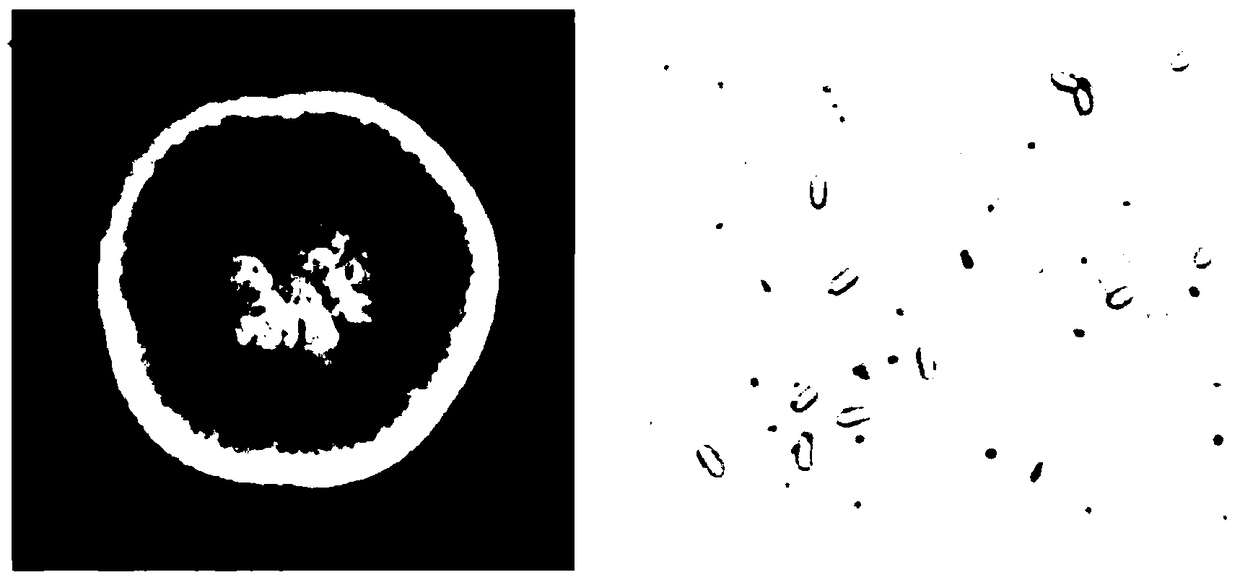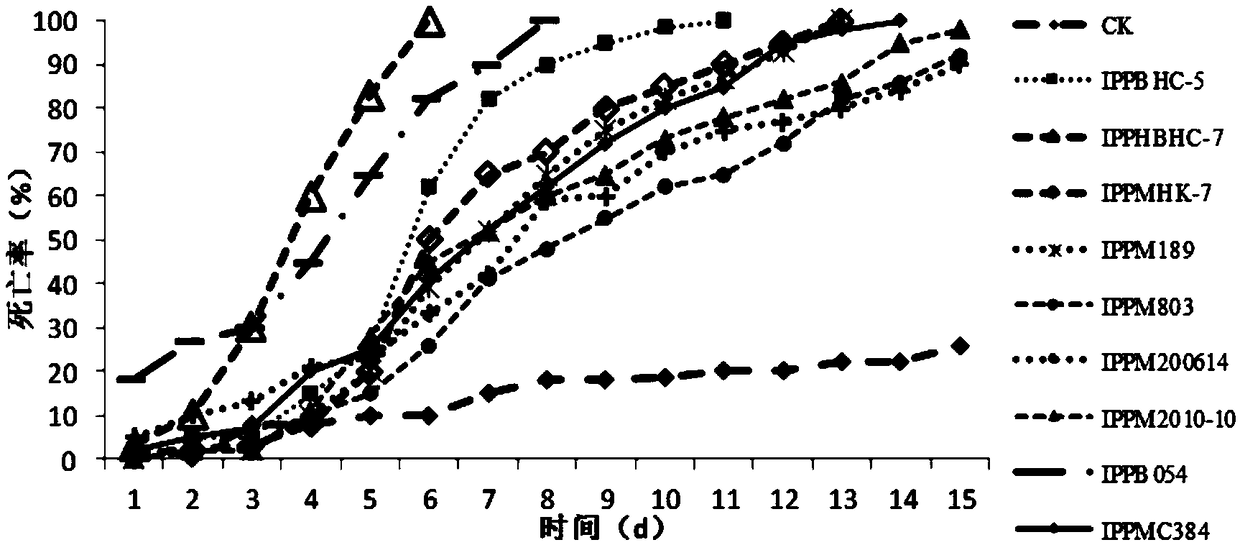Metarhizium anisopliae IPPMHBHC-7 and application thereof
A technology of scarab metarhizium anisopliae and locust, applied in the direction of application, fungi, biocides, etc., can solve the problems of fungal knockdown and slow action of killing pests, and achieve the effect of good application prospects
- Summary
- Abstract
- Description
- Claims
- Application Information
AI Technical Summary
Problems solved by technology
Method used
Image
Examples
Embodiment 1
[0032] Example 1 Screening and Identification of Metarhizium anisopliae IPPMHBHC-7
[0033] Metarhizium anisopliae strains were lured from the collected soil by the method of trapping Mellonella mellonella. Use the sterilized waste film box to load the soil samples for testing, bury one head of wax moth in each box, and repeat 3 times. The soil sample box is placed at 24-27°C, and after moisturizing and trapping for 1 week, the dead insects are sorted out, and after culturing for 7-10 days at a constant temperature of 25-26°C and a relative humidity of 100% RH, the target strain, strain The medium used for isolation was PDAY.
[0034] The isolated Metarhizium anisopliae was inoculated on the PDAY solid medium, and cultivated until sporulation, bacterial colony and spore morphology were as follows: figure 1 shown. Suspend the spore powder with 0.1% Tween water, shake evenly with a vortex shaker, and adjust the spore concentration to 1 × 10 8 individual / mL. Take 1 mL of the...
Embodiment 2
[0036] Example 2 Bioassay of the pathogenicity of Metarhizium anisopliae to the grasshopper nymph
[0037] The virulence effects of the above nine Metarhizium anisopliae strains on locusts were determined by stomach poisoning method.
[0038] First weigh 0.2g of Metarhizium anisopliae spore powder and add it to 2.0g of wheat bran, then add 0.1ml of edible oil, and stir well. Then weigh 0.2g of the prepared Metarhizium anisopliae wheat bran bait and put it into a petri dish, put it into a glass-covered insect rearing basket together with the petri dish, number them, and then put 20 of the same size into the insect rearing basket. 3rd instar hairy-legged locust gnat. In the blank control group, no Metarhizium anisopliae spore powder was added to the wheat bran bait. In this experiment, there were 10 kinds of Metarhizium anisopliae spore powders and one control CK. Each spore powder was repeated 3 times, that is, a total of 33 treatments, and they were raised in the insect cult...
Embodiment 3
[0046] Embodiment 3. Metarhizium anisopliae is to the bioassay of the pathogenicity of Asian locust
[0047] Determination of 9 bacterial strains is to the curative power of Asian carcus, and assay method is the same as the method for embodiment 2.
[0048] The bioassay results of the pathogenicity of 9 strains of Metarhizium anisopliae to P. image 3 ,Table 2.
[0049] Table 2 Comparison of the pathogenicity of 9 species of Metarhizium anisopliae to P.
[0050]
[0051]From the analysis in Table 2, it can be seen that the tested strains are pathogenic to locust gnats, the half-lethal time is between 3.55d and 10.67d, and the rate of dead insects is between 38.33% and 93.33%. Among them, the half-lethal time of the strain IPPMHBHC-7 was 3.55 days, and the zombie rate was 93.33%. Compared with the strain IPPM200614, etc., the strain IPPMHBHC-7 has significant differences, indicating that it has higher pathogenicity to P.
PUM
 Login to View More
Login to View More Abstract
Description
Claims
Application Information
 Login to View More
Login to View More - R&D
- Intellectual Property
- Life Sciences
- Materials
- Tech Scout
- Unparalleled Data Quality
- Higher Quality Content
- 60% Fewer Hallucinations
Browse by: Latest US Patents, China's latest patents, Technical Efficacy Thesaurus, Application Domain, Technology Topic, Popular Technical Reports.
© 2025 PatSnap. All rights reserved.Legal|Privacy policy|Modern Slavery Act Transparency Statement|Sitemap|About US| Contact US: help@patsnap.com



